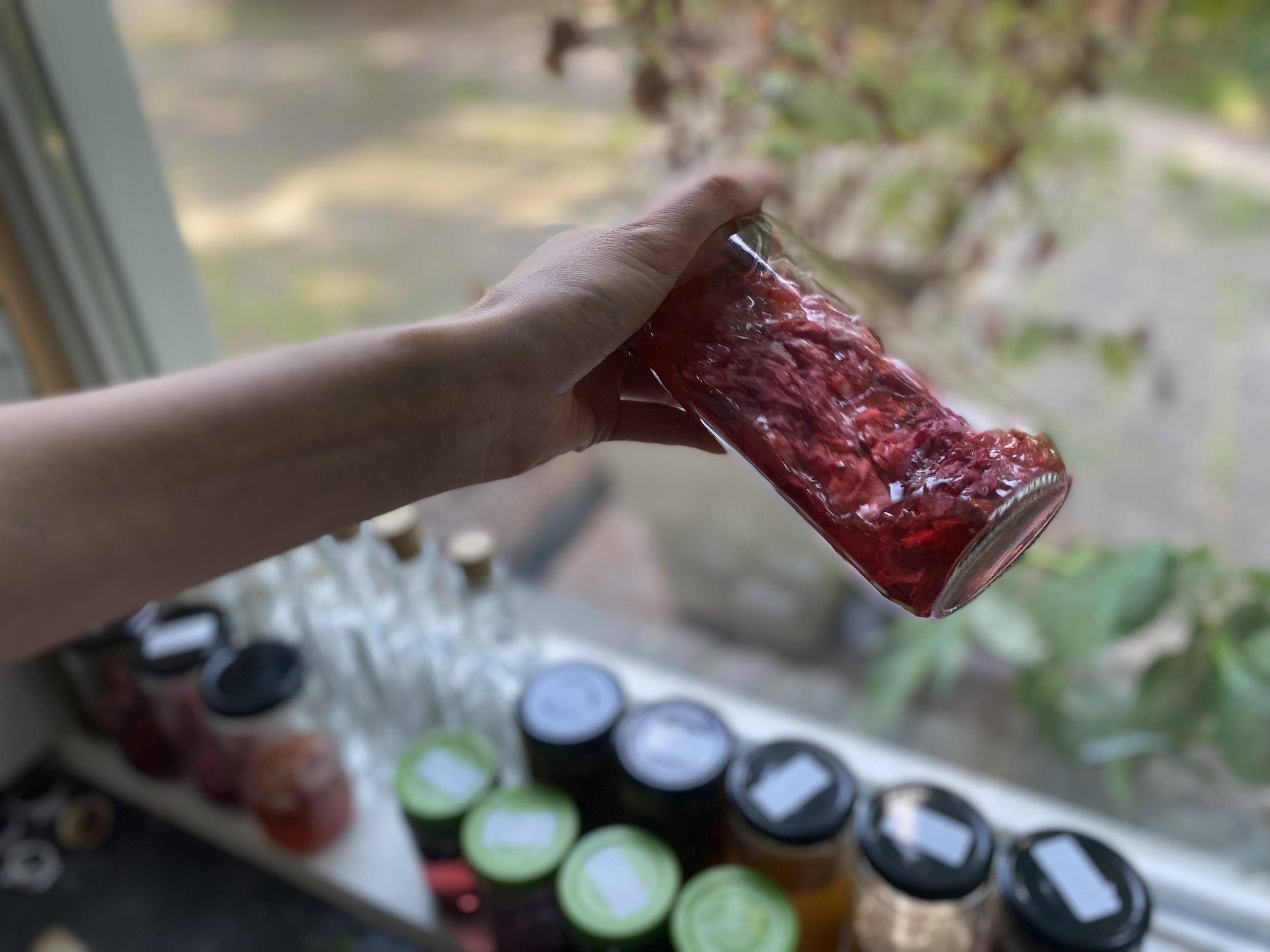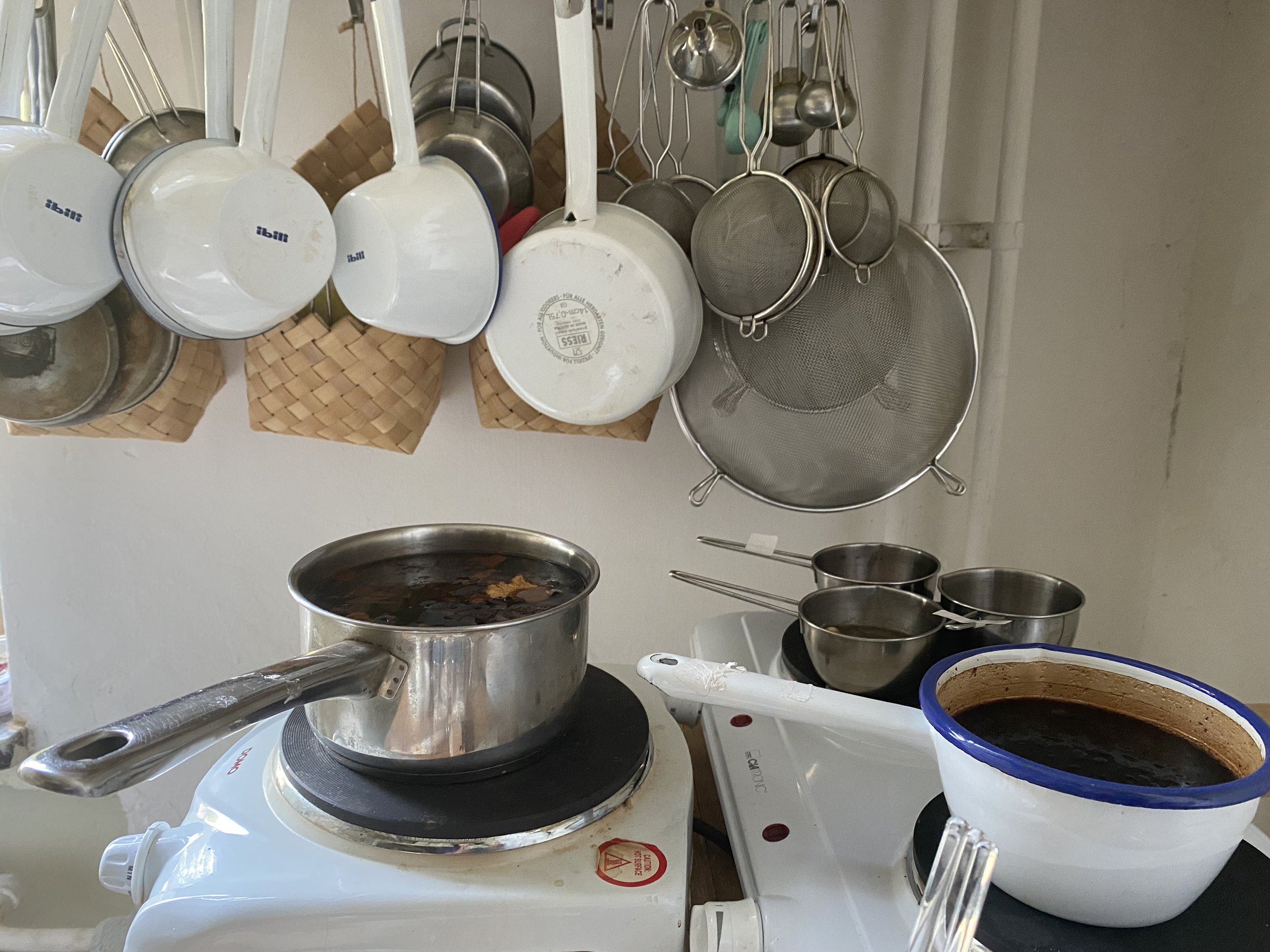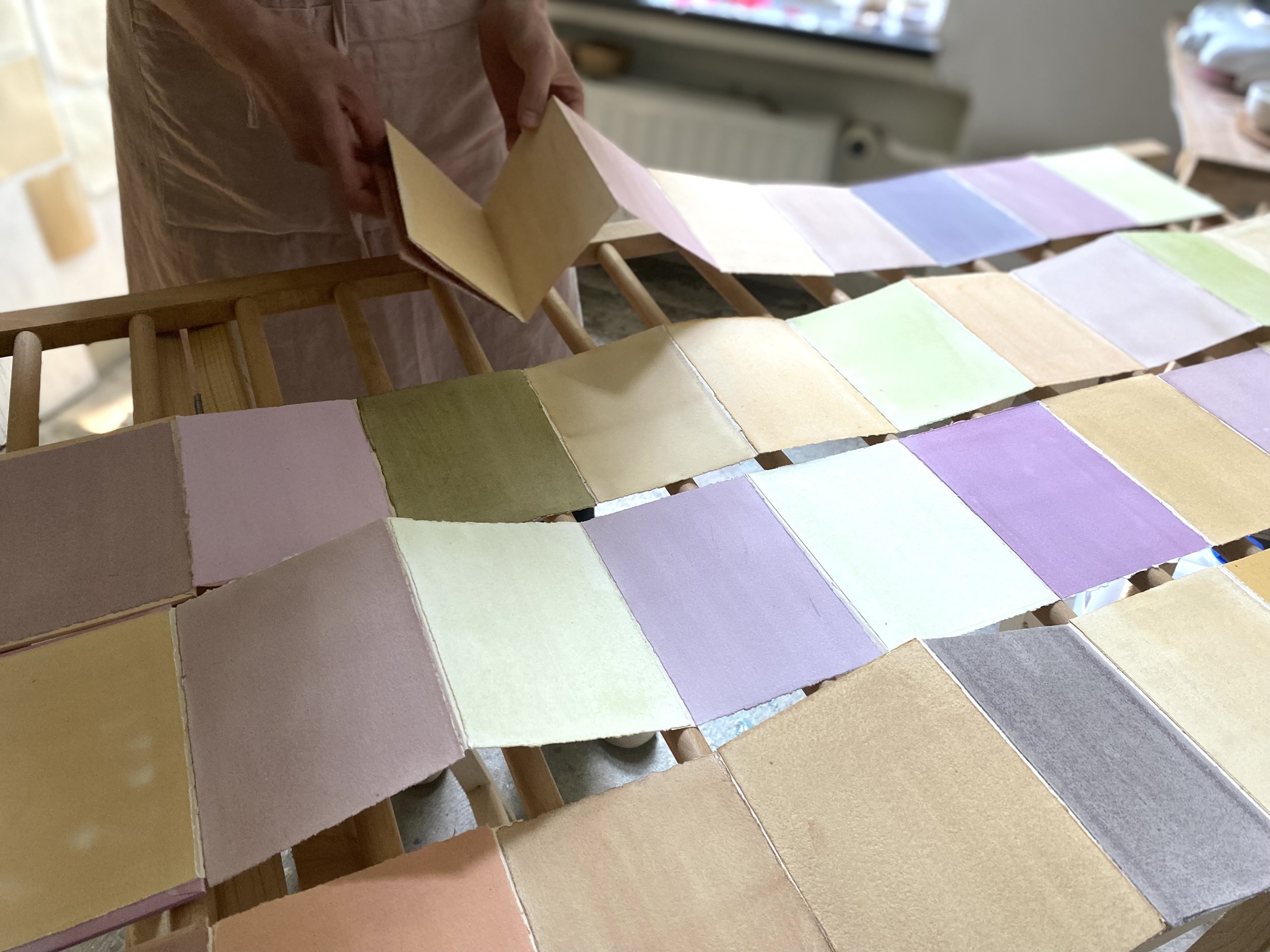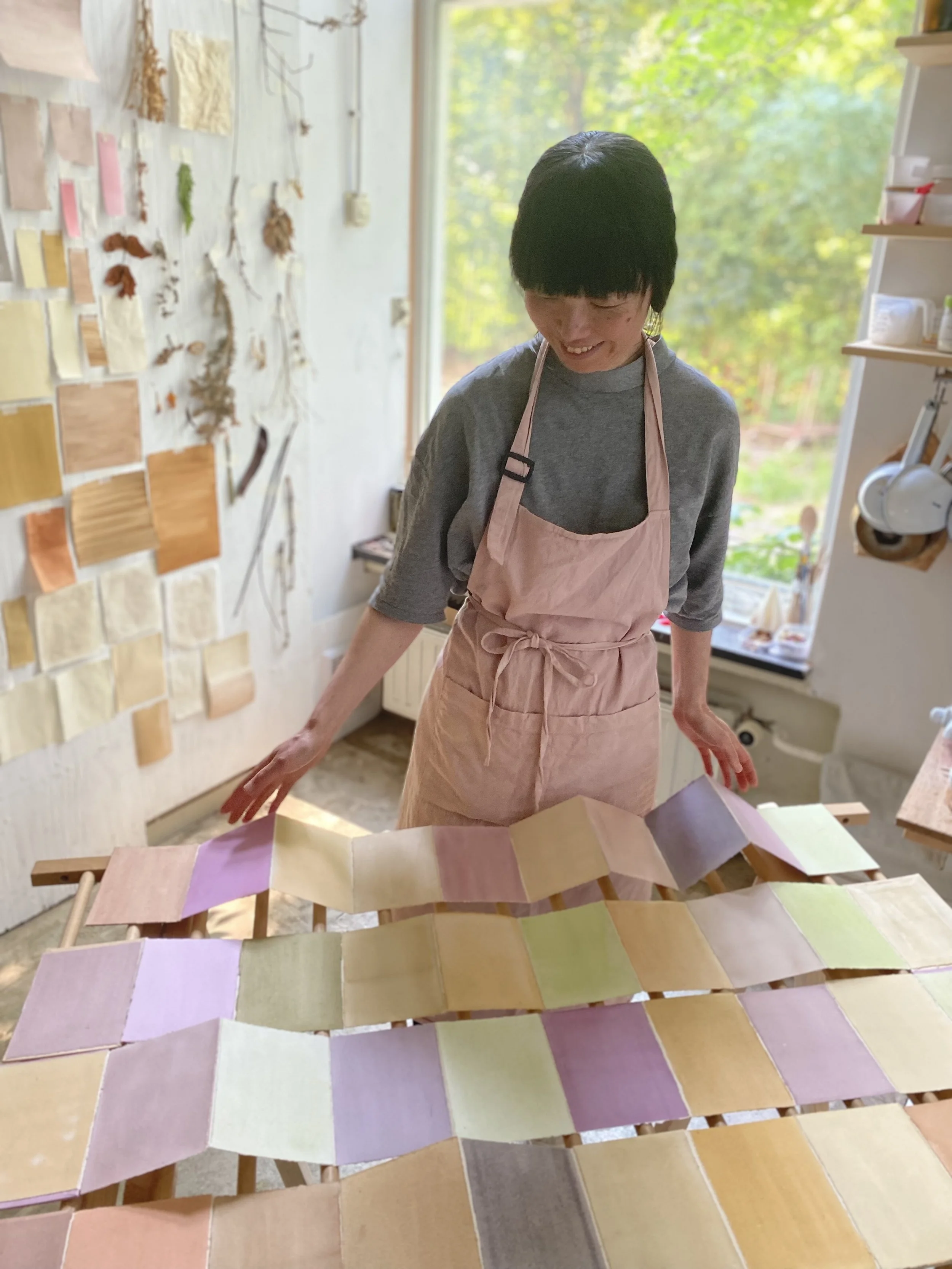Chika Ito
Discover the “background stories” of our diverse creatives. Join us on this journey. It is our pleasure to have Chika as our first interviewee!





Vol.1
Chika Ito, Niigata, Japan
Artist, Printmaker
Chika Ito is an Artist/Printmaker based in ‘s-Hertogenbosch, the Netherlands. She has been making her silkscreen inks, paints, and colors with safe edible materials for the last 25 years. Her works have been exhibited internationally and she has given workshops at schools and printmaking conferences in Dundee (Scotland), Hangzhou (China), Melbourne (Australia) and Tallinn (Estonia).
1. What is your favorite project? Why and how did you start?
My favorite project from the last few years is “Color Making Journey''. In 2020, during the Pandemic time, I met an Argentinian natural dyer through Social media. She asked me to make an online course for her students in Argentine, so I spend time with her making instruction videos and handouts in Spanish. It was very successful and I made a tag #colormakingjourney. Now, many people are making colors and posting what they make locally. I love how we discover colors and enjoy the process of making colors anywhere you are.
2. You lived and worked in Japan, the U.S., and The Netherlands. How has living in different countries/cities impacted the way in which you live, think and work?
Living in different countries and cities impacted me a lot. It opened up my perspectives to look at things and the world around us. By encountering other languages and different ways of communication, my Asian identity strengthened I think. In my head, my thoughts are often in English, and sometimes in Dutch and Japanese. It surely affects what I do and create.
3. What are your favorite tools/materials? And why are those important?
For tools, I like working with my hands, because I like to work directly. For the materials, I love paper. Since I was small, I was surrounded by many types of papers as they are everywhere in Japanese daily life, from Shinto sacred decoration to Origami. I was always fascinated about the transformation of paper, from a plant to fiber to paper. By very skilled Japanese artisans, plant materials are transformed into something extraordinary. Paper has a very important place in my life even though I have not lived in Japan for the last 30 years.
4. Do you have a specific process when approaching your work?
I take notes and make sketches when ideas come, but I have to be alone without destruction when I think about a new work.
5. Can you tell us about experiences that changed your views and approach to creativity.
In 2004, when I was in Japan, I saw a children’s book called “Soil collection” by Japanese artist Koichi Kurita. He travels and collects local soil, clean and grind them, and has been showing them as an installation for more than 10 years. Look at where you stand and observe the earth beneath you very closely. This way of approach and the beauty of his work really touched me.
“Look at where you stand and observe it very closely. This way of approach and the beauty of his work really touched me.”
6. Where do you get your inspiration for projects?
Many times, it starts with a word or a combination of words. By reading a book, or by writing ideas, some words resonate, and I take notes. From there, I make sketches. For example, I made an installation with 500 cards called “Ostara” in 2009. My neighbor is a writer and she told me about Ostara, the Spring goddess, and how her festival was celebrated at the Spring equinox in Europe. I made 500 drawings with egg yolk and egg white, and I made an installation at the local Church, with natural daylights in springtime.
7. Who are your biggest artistic/creative influences?
My parents made a huge impact on what I like and how I think. And my grandma. She never says “I don’t know” or “I cannot do it”, she always looks for creative solutions in daily life. Every time we go visit her in Japan, she has new ideas, recipes and inventions, and she is always open to change.
8. What motivates you to work as an artist?
Meeting many inspiring people from all disciplines and inspiring each other.
9. What's next for you?
Back to drawing, and silkscreen printing. Last few years, I was making more ink and not drawing or printing. Now is the time to create something with the ink I create.
Thank you Chika for sharing your inspiring journey!
Language editing by Studio Emit
Photography by Soonhwa Kang
Chika Ito
Artist, Printmaker
www.chikaito.com
instagram: atelierchikaito
Facebook: atelier.chikaito
E-mail: atelier@chikaito.com
Hanatoは、多様な国や地域で異なる文化を体験したり、既成の分野をこえて活動しているクリエイティブな人たちの軌跡と現在を、読者の皆様と一緒に辿っていきます。Hanato初めての記念すべきインタビューに答えてくださったのは、伊藤 愛(ちか)さんです。
伊藤愛(いとう・ちか)
アーティスト・版画家
新潟出身。オランダ、デンボス在住。
25年間、安全で食べることのできる材料でシルクスクリーンのインクや、顔料をつくっている。オリジナルのインクで制作した作品は、世界各国で展示され、また、スコットランドをはじめ、中国、オーストラリア、エストニアなどで、印刷・版画のカンファレンスに参加、ワークショップを意欲的に開催している。
思い入れのあるプロジェクトについて教えてください。どのようにそのプロジェクトを始めましたか?
ここ何年かで思い入れのあるプロジェクトは”Color Making Journey”です。2020年のコロナ禍の真っ最中に、ソーシャルメディアで出会ったアルゼンチン人の染色家の方に依頼を受けて、彼女の生徒向けに食べられるものを使った色作りのオンラインコースを作ることになりました。彼女と一緒に動画を作ったり、資料等もスペイン語で作りました。結果は大成功で、たくさんの方が参加してくださいました。この時に#colormakingjourneyというタグが生まれて、今でもたくさんの方が地元にあるものを使って色を作り、ソーシャルメディア上に投稿しています。どこでも誰でも新しい色を発見できて、色作りが手軽に楽しめるということは本当に素晴らしいと思います。
さまざまな国に住んだことがあるようですが、異なる国で活動することは、現在の生活、また考え方や働き方にどんな影響がを与えましたか?
いろいろな国で生活したということからはすごく大きな影響を受けています。ありとあらゆる物事や、周りに広がる世界を見る視野がぐんと広がりました。他の言語や異なるコミュニケーションの方法に出会うことで、逆に私のアジア人としてのアイデンティティーが強くなったようにも思います。普段は頭の中では英語でアイディアを考えていることが多く、オランダ語や日本語も時々混じります。このプロセスは私の行動や作るものにも影響を与えていると思います。
普段頻繁に使用している、なくてはならない道具や材料は何でしょうか?それらを使用することは、なぜ重要なのでしょうか。
道具というよりも、直接自分の手を使って作業したり、ものを作るのが好きです。材料としては紙が好きです。日本に暮らしていると神社に飾ってあるシデやもっと身近なところでは折り紙など、暮らしの中のありとあらゆる場面で紙に遭遇します。紙は植物から採れる繊維からできているということに長い間とっても魅了されています。日本の紙職人さん達の技で植物が紙という万能な素材に生まれ変わるのです。日本を離れて30年近くになりますが、紙は私の人生の中でいまだにとても重要な位置づけにあります。
プロジェクトにとりくむとき、特別なプロセスがありますか?
大体ノートを取ってスケッチをすることから始めます。これは必ず、静かな集中できるところで一人でやります。
創作活動をする上で、視点やアプローチに影響を与えた出来事や経験を教えてください。
2004年に日本に一時帰っていた時に、図書館の子供コーナーで、栗田宏一さんの”土のコレクション”という本に出会いました。栗田さんは今ではとても有名な方で、世界中を旅して土を集め、ゴミを取り除き、綺麗に乾かして土そのままを展示する、という発表の仕方を何十年もされています。自分の立っているところをよくみつめ、土を注意深く観察する。このアプローチの仕方と彼の作品の美しさに本当に感動しました。
インスピレーションがわくのはどういう時ですか?
本を読んだり考えを書き綴っていく中である単語が気になったり、単語の組み合わせが閃いたり。そういうときにはさらにスケッチが進みます。2009年に制作した”Ostara”という作品では、500枚のカードからなるものだったのですが、近所に住む作家から聞いた”オスタラ”という春の女神とヨーロッパで春分を祝う同じ名前のお祭りについて想像が広がり、卵白と卵黄を使っての制作をしました。発表は地元の教会の自然光を使って春に行われ、とてもラッキーでした。
どんな人があなたに強い影響を与えましたか?
両親からは大きな影響を受けています。そして私の祖母からの影響も大きいです。彼女は知らない、できない、ということをせず日々の生活で生まれる問題に自分なりにとってもクリエイティブに立ち向かいます。93歳となる今でも、良い結果が出れば常に新しいことを試していて、いつも最新のレシピや生活の工夫を教えてくれたり、年老いても変化にとてもオープンなのがすごいと思います。
創作活動していく上で、どんなことが原動力になっていますか?
あらゆる分野で活躍する方々から刺激をいただいて、お互いに高めあっていけることが原動力になっています。
次の計画を教えてください!
コロナ禍で制限があったりしてここ2年ほどはインク作り中心に発信していましたが、これからはそのインクを使ってもっとドローイングや版画などで作品を作っていきたいと思います。
ちかさん、貴重な経験を共有してくださってありがとうございました。

